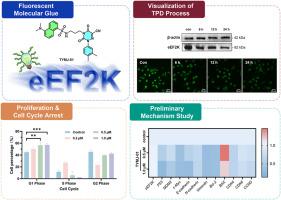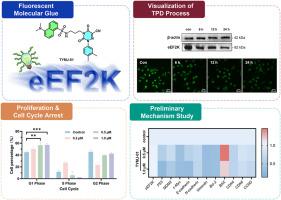Discovery of fluorescent theranostic molecular glues for real-time visualization and target degradation toward eEF2K
IF 5.9
2区 医学
Q1 CHEMISTRY, MEDICINAL
引用次数: 0
Abstract
Eukaryotic elongation factor 2 kinase (eEF2K) plays a significant role in tumor cell adaptation under metabolic stress and serves as a promising target for cancer therapy. Nowadays, the research about target protein degradation (TPD) technology is still in the ascendant, which led to the PROTACs and MGs that induce eEF2K degradation. However, few approaches could realize the real-time monitoring of TPD process, hindering the understanding of protein degradation and the effect it caused. In this study, a series of novel fluorescence theranostic probes (TYMJ-01∼06) was rationally designed and synthesized, based on an MG targeting eEF2K. As the representative probe, TYMJ-01 exhibited superior degradation efficiency (DC50 = 82 ± 12.57 nM, Ymin = 27.14 ± 12.6 %) for eEF2K through the ubiquitin–proteasome pathway, as well as outstanding capability of dynamic fluorescence imaging toward intracellular eEF2K degradation in TNBC cells. Furthermore, the probe maintained significant inhibition of cell proliferation, migration, and invasion, and enhanced the antitumor activity of paclitaxel in combination treatment. Therefore, a reliable and efficient toolkit would be provided for eEF2K mechanism study and corresponding drug discovery. Our work could also be beneficial to the study and establishment of TPD and the visualization of a dual-functional system.


用于实时可视化和eEF2K靶标降解的荧光治疗分子胶的发现
真核延伸因子2激酶(Eukaryotic伸长factor 2 kinase, eEF2K)在肿瘤细胞代谢应激下的适应中起着重要作用,是肿瘤治疗的一个有希望的靶点。目前,靶蛋白降解(target protein degradation, TPD)技术的研究还处于起步阶段,这导致了诱导eEF2K降解的PROTACs和MGs的出现。然而,很少有方法可以实现对TPD过程的实时监测,阻碍了对蛋白质降解及其影响的认识。本研究以靶向eEF2K的MG为基础,合理设计合成了一系列新型荧光治疗探针(TYMJ-01 ~ 06)。作为代表性探针,TYMJ-01通过泛素-蛋白酶体途径对eEF2K表现出优异的降解效率(DC50 = 82±12.57 nM, Ymin=27.14±12.6%),并且对TNBC细胞内eEF2K降解具有出色的动态荧光成像能力。此外,探针对细胞增殖、迁移和侵袭均有明显的抑制作用,增强了紫杉醇联合治疗的抗肿瘤活性。因此,为eEF2K机制研究和相应的药物发现提供了一个可靠、高效的工具箱。本研究对TPD的研究和建立以及双功能系统的可视化具有一定的指导意义。
本文章由计算机程序翻译,如有差异,请以英文原文为准。
求助全文
约1分钟内获得全文
求助全文
来源期刊
CiteScore
11.70
自引率
9.00%
发文量
863
审稿时长
29 days
期刊介绍:
The European Journal of Medicinal Chemistry is a global journal that publishes studies on all aspects of medicinal chemistry. It provides a medium for publication of original papers and also welcomes critical review papers.
A typical paper would report on the organic synthesis, characterization and pharmacological evaluation of compounds. Other topics of interest are drug design, QSAR, molecular modeling, drug-receptor interactions, molecular aspects of drug metabolism, prodrug synthesis and drug targeting. The journal expects manuscripts to present the rational for a study, provide insight into the design of compounds or understanding of mechanism, or clarify the targets.

 求助内容:
求助内容: 应助结果提醒方式:
应助结果提醒方式:


